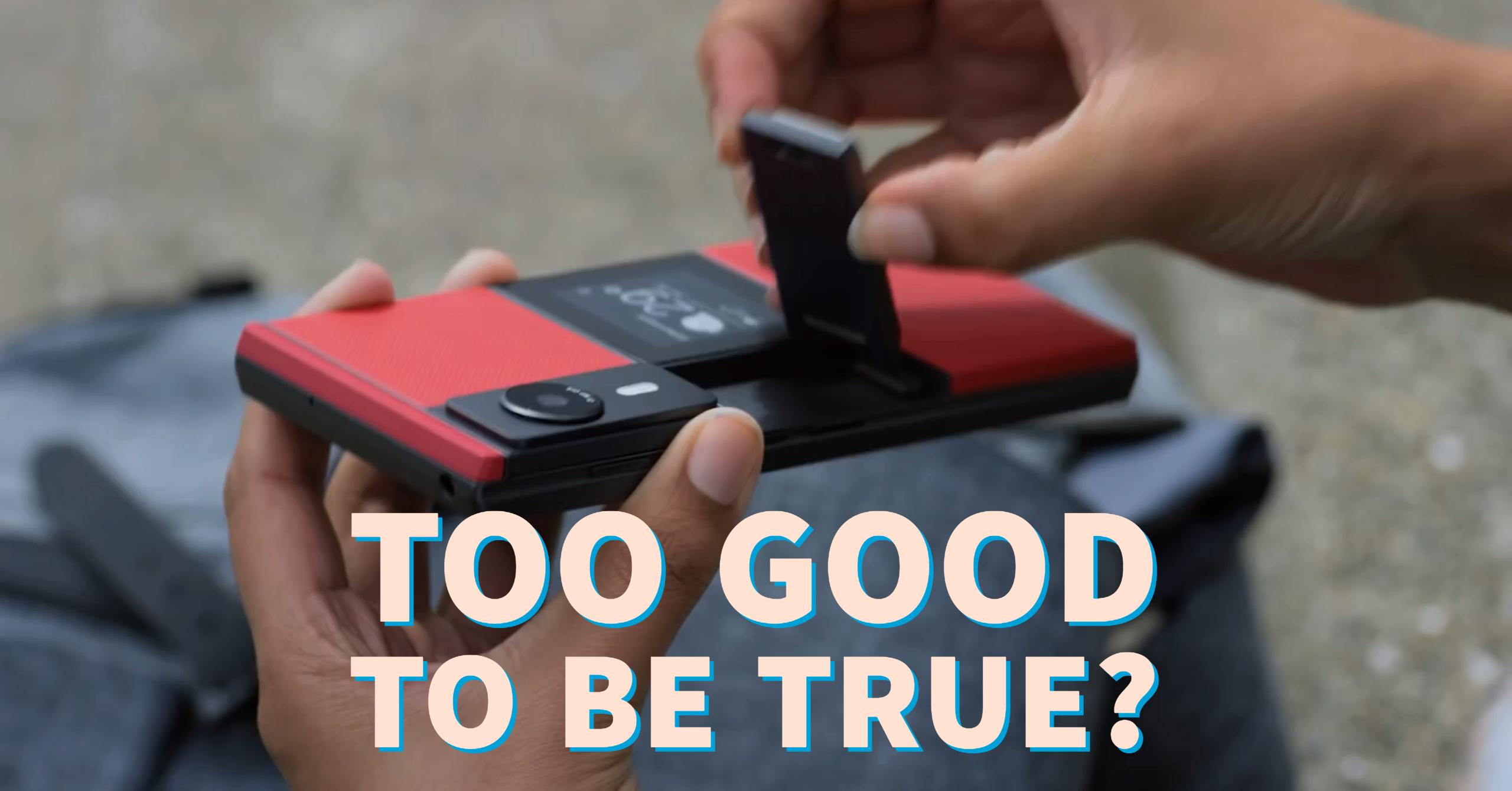While still unchartered territory to mainstream consumers, the entire prospect of modular smartphones is very exciting to geeks everywhere. Modular phones offer the chance for their ‘creators’ to mix and match hardware as they please to suit different needs, like how it’s currently done with personal computers.
All of this is done in the name of reducing e-waste and letting phones live on for more than the biennial life cycles, where most people replace their mobile phones when their plans are due for re-contract.
Phonebloks – The World’s Introduction To Modular Phones
Modular phones are by no means a new concept, but they rose to prominence three years ago because of Phonebloks.
I still vividly remember the day Phonebloks burst onto the social media landscape in September 2013, gaining viral status almost instantaneously. I found my news feed flooded with its introductory video shared by everyone – from tech and news sites, to many of my own friends. There was an air of excitement for this new revolutionary concept for smartphones.
The buzzword within the tech industry even until now, is ‘disrupting’ current technologies. Everyone, from the big players to the lean startups, are in an arms race to out-innovate each other.

“Electronic Devices Are Not Designed To Last “
The brainchild of Dutch designer Dave Hakkens, early prototypes of Phonebloks looked liked some mutation of Lego stuck on a circuit board. The squarish design is clearly just an initial idea, so people weren’t really expecting a svelte device from the get go.
Though lacking a proof of concept, or any kind of prototype for that matter, the device was still covered by major press in the world. This inevitably caught the eye of a certain Google Inc. and things got serious almost immediately.
The Rise Of Project Ara

Hakkens told Techradar that he wasn’t aware that Motorola, still under Google in 2013, had something similar cooped up within its lab, Project Ara. Its presence made the partnership all the more sensible.
Now with Phonebloks absorbed into Project Ara, work got underway and prototypes were developed. The design was also being overhauled to suit the tastes of the current generation.

A year on, with Motorola sold to Lenovo, Project Ara is now solely a Google entity. As for the phone itself, this resulted in a more streamline redesign of the modular smartphone concept – something that looked like it was ready to run alongside other flagships at the time, albeit being a prototype.
Along the way, other companies also jumped on the bandwagon to develop modules for Project Ara, most notably of which was Toshiba.
Fast forward another year to 2015, and Google released more updates to the world. In an introductory video, we could more or less know the direction that development will take Project Ara.
Geared to the everyday user, Google is trying to highlight the endless possibilities of having a modular phone. We also now have a clearer view of the partner companies that will be developing the modules for the phone. We have Kingston, known for their storage and memory, Marvell taking on the responsibility of networking and Nest bringing home monitoring expertise to your phones. Fujitsu is presumably taking charge of internals such as circuit boards, and as we found out earlier, Toshiba will bring the camera modules to the phone.
It’s been three years, so where’s the phone now?
Google plans to release developer samples by Fall of this year with an aim to release consumer models in 2017.
It’s actually happening – modular smartphones are upon us. In the latest video released by Google, we can see the departure from having many smaller modules, like the original Phonebloks concept, to larger more manageable modules. In the video, they vividly show the many use case scenarios where having a modular phone will be to your advantage. Sounds plausible so far.
Why It Might Not Takeoff Immediately
1. Cost
As we’ve learnt from many instances of tech hardware today, shrinking anything in size will correspondingly increase its price. For example, an ultrabook sometimes costs more than a gaming laptop; a Mini ITX PC is always more expensive than building a gargantuan ATX PC. Compartmentalising parts adds on costs too.
Just take a look at the Razer Core, billed by most as an expensive case for your graphics card. The Razer Blade Stealth ultrabook that’s supposed to accompany it, on the other hand, is seen as more competitively priced.

The added cost of having multiple modules also contributes to the case against it.
A real life example of this comes from LG’s recently released G5 flagship smartphone. The phone itself is by no means affordable to everyone, with it being a top of the line model.
However, the sucker punch comes from its ‘friends’, which comes in a combination of two replaceable bottom modules for the phone – a 360 degree camera and a rolling drone. The cost of the two additional modules alone can buy you an entirely new phone, and one with respectable specifications at that.
2. The Modules
While we’re sure Google will provide the full list of partners manufacturing future modules eventually, there’s concern that the promise of customisability will, at the start, be undelivered.
To reduce the number needed to cover the phone, modules have already been enlarged – this was done presumably to make the phone and the modules easier to manufacture. The Ara frame also contains the CPU, GPU, antennas, sensors, battery and display. Remember how early prototype videos show off how you could replace the screen easily when you damage it? Well, that prospect is now long gone – you are now limited to the ‘extras’, and these come in the form of cameras, speakers, and add-ons such as batteries, sensors and mini displays.

Then there’s the issue of durability. Having loose modules connect externally through magnets and connectors doesn’t really inspire as much confidence as having your components encased in an aluminium uni-body, as bendable as it can be. Also, what’s stopping anyone from being mischievous and sliding out your modules without your knowledge? Whether the plug and play nature of the modules will include security measures such as locking mechanisms is still unknown, but I do wish that this would be taken into consideration.
Lastly, as if losing your phones isn’t bad enough, you are now more susceptible to losing parts of your phone. Talk about frustrating!
3. People Don’t Care As Much As Creators Imagined They Would
Perhaps the most important reason of all – people don’t care enough.
The excitement that Phonebloks brought to the masses has more or less died down, with people reverting back to the overlords of Samsung and Apple for their next smartphone purchase. This article by John Brownlee at FastCoDesign comes to mind, with the title pretty much summing it up: Why Lego Design Principles Don’t Work On Smartphones. In it, he explains how most people are ignorant about the parts that make up the phones they use every day – a sentiment geeks will attest to immediately. You can try pinpointing any of your friends, and I can guarantee that there’s an high chance that he or she will struggle to name the components and their manufacturers.

The reason is simple – people don’t care about the nitty-gritty details as long as their phone works well and does its intended job.
More often than not, people are more than willing to queue up for hours at service centres to repair their damaged phones or, for the less fussy, simply live with the defects. The iPhone has single-handedly made using a phone with a cracked screen fashionable, with cracked phone screens being a common sight.
Finally, with a modular phone which offers replaceable parts, the excitement of buying an entirely new phone with a sleek, upgraded design will be gone.
Where That Leaves Us
Until a full consumer version of Project Ara is available to the masses, its functions are purely speculative at this point. We just hope that Google gets this right, because it’s been a long time coming since Phonebloks.
While the general public may not take it to immediately, sowing the seeds early of a utopia where you upgrade your phone one module at a time may just be what Project Ara can bring.
Featured Image Credit: Google








